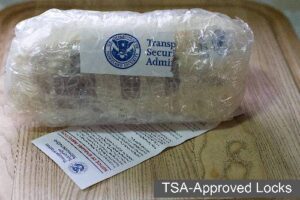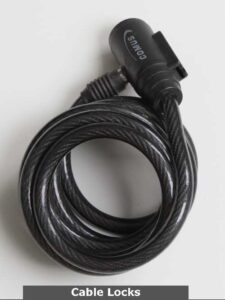
Securing your luggage is a pivotal aspect of stress-free travel, and in this comprehensive guide, we will look into the art of ensuring how to set the lock on away luggage. As seasoned travellers know, the peace of mind that comes from knowing your belongings are safe is priceless.
Whether you’re a frequent flyer or an occasional explorer, understanding the nuances of luggage security is essential in today’s world, where theft and security breaches pose concerns.
How to Set the Lock on Away Luggage- Why Luggage Security Matters?
Travelling brings excitement, adventure, and new experiences, but it also comes with the responsibility of ensuring the security of your belongings. Especially during long-haul flights, it’s essential to keep your luggage lock secure.
Additionally, if you wish to store your luggage or entrust it to someone travelling to the same destination cheaply through a secure app like Lifti, it becomes imperative to ensure the security of your belongings.
Let’s see why luggage security matters.
1. Rising Concerns of Theft and Security Breaches
In the fast-paced world of travel, instances of theft and security breaches have become unfortunate realities. Baggage handlers, fellow travellers, or even opportunistic individuals may pose a risk to your belongings. Understanding the potential risks emphasizes the importance of implementing effective security measures.
2. Consequences of Inadequate Luggage Security
The consequences of inadequate luggage security can range from inconveniences to significant disruptions in your travel experience. Lost or stolen items can not only impact your journey but may also result in financial losses and emotional distress. Recognizing these consequences underscores the necessity of prioritizing luggage security.
3. Emphasizing Peace of Mind
The true essence of secure travel lies in the peace of mind it provides. Knowing that your belongings are protected allows you to focus on enjoying your journey without the constant worry of potential theft or loss. By taking proactive steps to secure your luggage, you’re investing in a smoother and more enjoyable travel experience.
Different Types of Luggage Locks
When it comes to securing your luggage, the type of lock you choose plays a crucial role in determining the level of protection your belongings receive. Following are the common types of luggage locks available, along with their pros and cons:
A. Common Types of Luggage Locks
1. Padlocks

Padlocks, simple and versatile, are a popular choice for travellers seeking how to set the lock on away luggage. These locks, often lightweight and easy to use, provide a basic level of protection. However, it’s crucial to note that padlocks may not deter determined thieves, and their susceptibility to tampering should be considered.
2. Combination Locks

Offering the advantage of not requiring keys, combination locks provide a customizable code for added security. While convenient, the challenge arises when resetting the code, which can be cumbersome. Despite this drawback, the absence of keys eliminates the risk of losing them during your travels.
3. TSA-Approved Locks

Recognized by the Transportation Security Administration (TSA), these locks are designed to allow airport security to inspect your luggage without damaging the lock. While providing a degree of convenience, TSA-approved locks have limitations in terms of customization due to the necessary key access granted to TSA.
4. Cable Locks

Known for their flexibility, cable locks are versatile in securing various types of luggage. However, it’s essential to acknowledge that their level of security may not be as robust as more specialized lock types. While effective in preventing opportunistic theft, determined individuals may find ways to compromise cable locks.
B. Recommendations Based on Travel Needs
Choosing the right lock depends on your specific travel requirements. For short trips, a simple padlock might suffice, while frequent flyers may opt for the convenience of TSA-approved locks. Consider the nature of your travels and the level of security you desire when making your selection.
Here is a video that can help you understand how to secure your luggage during travel.
How to Set Lock on Away Luggage-
Step-by-Step Guide
Securing your luggage starts with mastering the lock-setting process. Follow this step-by-step guide to ensure your belongings are protected throughout your travels:
Start with a Checklist of Items to Secure in Your Luggage
Starting the process of securing your luggage begins by carefully taking stock of your belongings. Before adding any locks, make a checklist of items that require extra protection. Think about including electronics, important documents, and personal items that hold sentimental or monetary value. This initial step not only assists you in prioritizing the significance of each item but also ensures that you are attentive to the specific security requirements for your possessions.
Step 1: Choosing the Right Lock
The first step in the art of luggage security is selecting the right lock for your needs. The choice of lock depends on your preferences, travel habits, and the level of security you seek.
Padlocks are a straightforward choice, offering simplicity and portability. They are lightweight and easy to use, making them suitable for various types of luggage. However, it’s essential to acknowledge that while padlocks are convenient, they may provide minimal security and could be susceptible to tampering.
Combination locks present an alternative, eliminating the need for keys and allowing for a customizable code. This feature is particularly beneficial for those who wish to avoid the risk of losing keys during their travels. However, it’s worth noting that resetting the code can be a challenge, and the code chosen should strike a balance between security and memorability.
For those navigating airports frequently, TSA-approved locks provide a solution. Recognized by airport security, these locks allow TSA agents to inspect your luggage without damaging the lock. While convenient for travel, these locks come with the trade-off of limited customization due to the necessary key access granted to TSA.
Step 2: Setting the Combination
Setting the combination on your polycarbonate Away suitcase lock is a straightforward process that ensures a secure and memorable code. Follow these detailed instructions for a seamless experience
1. Begin with the Lock Open and Zipper Pulls Released
- Ensure your suitcase is open, and the zipper pulls are released.
- Confirm that the dials on the combination lock are set to 0-0-0.
2. Push the Reset Button
- Locate the reset button, a small square button next to the number dials.
- Use a pen or pointed object to push the reset button down until it clicks.
- No need to keep holding it down; it will automatically stay in the down position.
3. Set Your Desired Combination
- Roll the digits on the dials to the combination of your choice.
- Choose a combination that is secure but easy for you to remember.
4. Slide the Latch and Confirm
- Once your chosen combination is set, slide the latch towards the dials.
- The reset button will pop back up, indicating that your new combination is securely in place.
Following these steps ensures that any kind of Away suitcase is equipped with a personalized and secure combination. This process not only provides enhanced security for your belongings but also offers the convenience of a customizable code tailored to your preferences.
Step 3: Securing Zippers and Additional Features
Beyond the combination lock, securing zippers and exploring additional features on your luggage adds an extra layer of protection to your belongings. Consider the following steps:
1. Utilizing Built-in Locking Mechanisms
- Many modern suitcases, including Away luggage, come equipped with built-in locking mechanisms. Familiarize yourself with these features, as they can provide an additional safeguard against unauthorized access.
- Some suitcases have lockable zippers, where the zipper pulls can be secured together with a small lock. This adds an extra deterrent to casual theft.
2. Using Cable Ties or Straps for Added Security
- For an added layer of security, consider using cable ties or straps to secure your luggage. These are particularly useful if your suitcase lacks built-in locking features.
- Thread the ties or straps through the zippers or around the suitcase handles, making it more challenging for potential thieves to access your belongings.
How to Reset a Luggage Lock?
Resetting a luggage lock is a valuable skill, especially if you need to change your combination or if you forget the current one. Here’s a step-by-step guide on how to reset a typical combination lock.
- Most combination locks have a small reset button that needs to be engaged for the reset process. Find this button; it’s usually situated near the dials.
- Use a pen or another pointed object to press and hold the reset button. Keep it pressed down throughout the entire process.
- While holding the reset button down, rotate the dials to set a new combination of your choice. Ensure that the numbers align precisely with your desired code.
- Once you’ve set the new combination, release the reset button. It should pop back up, indicating that your new combination is now in effect.
- Before locking your luggage, test the new combination to ensure it opens smoothly. This step avoids potential issues during your travels.
Remember to choose a combination that is both secure and easy for you to remember. Regularly updating your combination adds an extra layer of security to your luggage.
How to Open a Suitcase Number Lock?
Opening a suitcase with a number lock involves a straightforward process. If you’ve set a combination and need to access your belongings, follow these steps.
- Ensure that the dials on the number lock are aligned with the combination you initially set. This is the key to successfully unlocking your suitcase.
- Hold the suitcase handle or body and apply slight pressure. This pressure helps the internal mechanisms align correctly.
- Begin rotating the dials sequentially, starting with the first number of your combination. Turn each dial until you reach the corresponding number in your combination.
- Repeat the process for each dial, moving in the order of your combination. As you reach the correct number on each dial, you should feel a subtle give or click.
- Once you’ve aligned all the dials with your combination, the lock should be released. Open your suitcase to access your belongings.
Remember to handle the dials carefully, and apply gentle pressure throughout the process. If at any point you face resistance, double-check that the dials are accurately aligned with your combination.
Troubleshooting and Tips
As you set out to become proficient in luggage security, it’s crucial to be ready for possible challenges and to incorporate extra tips for added protection.
A. Addressing Common Issues When Setting Locks
Setting locks may encounter occasional challenges, but being equipped with troubleshooting solutions ensures a smooth process:
1. Forgotten Combination
If you forget your combination, refer to the lock’s manual for specific instructions on resetting it. Keep a secure record of your combination in a separate location (Like in your phone’s contact, Email or Notepad) to avoid this issue.
2. Stuck or Jammed Lock
Apply a small amount of lubricant, such as graphite powder, to unstuck locks. Gently tap the lock with a solid object to dislodge any debris that may be causing the jam.
B. Additional Tips for Enhanced Security and Ease of Use
1. Regularly Update Your Combination
Change your lock combination periodically for added security. Avoid using easily guessable combinations to enhance protection.
2. Secure Valuables in Inner Pockets
Place valuable items in the inner pockets of your luggage for an added layer of concealment. This ensures that even if someone gains access to your luggage, your most important belongings remain secure.
3. Use Tamper-Evident Seals
Consider using tamper-evident seals on your luggage to indicate if it has been opened during transit. These seals are designed to break if someone attempts to open the suitcase without your knowledge.
4. Invest in RFID Blocking Accessories
If carrying electronic devices with RFID technology, invest in RFID-blocking accessories to prevent unauthorized scanning of your personal information.
By addressing common issues and incorporating these tips, you not only troubleshoot potential challenges but also elevate the overall security of your luggage.
TSA Guidelines and Compliance
A. TSA Regulations on Luggage Locks
Getting through airport security requires a crucial understanding of the Transportation Security Administration (TSA) regulations related to luggage locks. The TSA recognizes the importance of keeping passengers’ belongings secure while also providing a system for authorized inspections. TSA agents have the authority to inspect luggage during security checks, and to facilitate this process without compromising security, they may need access to your suitcase. This recognition forms the basis for TSA-approved locks, designed to strike a balance between protecting your possessions and allowing necessary security measures.
B. Setting Locks that Comply with TSA Requirements
When it comes to selecting and setting locks for your luggage, aligning with TSA requirements is paramount for a hassle-free travel experience.
1. Choosing TSA-Approved Locks
Opt for locks that bear the TSA-approved symbol, typically represented by a red diamond-shaped logo. This symbol indicates that the lock complies with TSA standards and can be easily opened by authorized TSA personnel if necessary.
2. Understanding Key Access
Recognize that TSA agents may need to access your luggage during security checks. Ensure that the lock you choose allows for secure and authorized key access, preventing damage to the lock while accommodating the need for inspection.
3. Benefits of Using TSA-Approved Locks
TSA-approved locks facilitate a more seamless security check process. These locks are crafted to allow TSA agents to inspect your luggage without resorting to destructive measures like cutting the lock. The result is a faster and smoother security screening, minimizing the inconvenience for both travellers and security personnel.
The universal standards set by the TSA resonate internationally. Opting for TSA-approved locks ensures your compliance not only within the United States but also on a global scale. International airports recognize and respect these locks, ensuring a consistent approach to luggage security regardless of your travel destination.
Choosing TSA-approved locks is a strategic decision that not only aligns with regulations but also enhances your overall travel experience. The benefits extend beyond security, contributing to the efficiency of airport operations and providing peace of mind for the conscientious traveller.
Conclusion
In summary, acquiring proficiency in setting the lock on your Away luggage is more than just a travel skill, it is a vital measure to guarantee a hassle-free journey.
This comprehensive blog post empowers every traveller by addressing the growing concerns of theft and security breaches, exploring various lock types, and providing a detailed step-by-step guide. From selecting the right lock to troubleshooting common issues and following TSA guidelines, this guide covers every aspect, underscoring the significance of assured security for a hassle-free travel experience.

